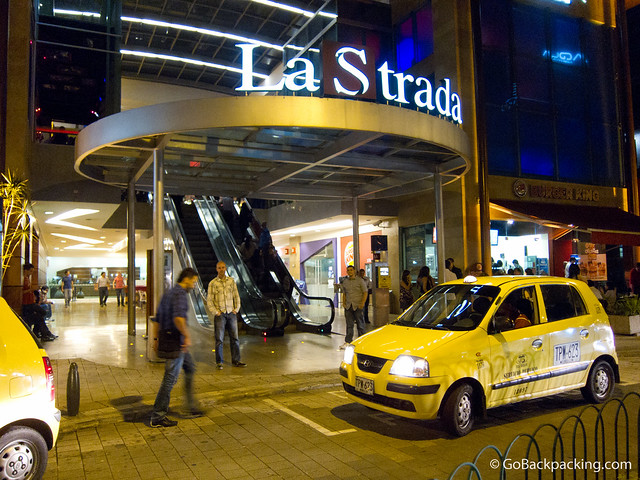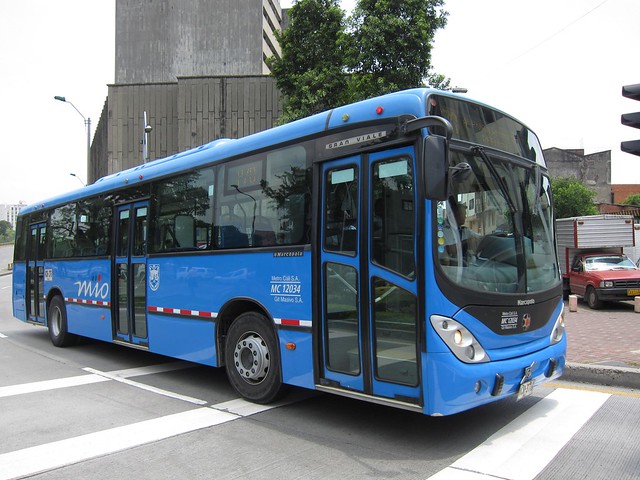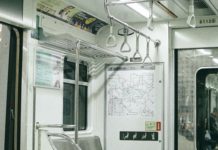
The potent smell of fried empanadas drifts through the window.
Horns are sounding all around as death-defying motorcyclists speed around gigantic buses overflowing with people.
A man wears a clown nose and juggles three red balls at the intersection up ahead.
The sounds of salsa and reggaeton blend together in a musical symphony that permeates from all the other vehicles as taxi drivers croon along.
Slowly, the sun rises over the Farallones in the distance as color crayon blue MIO buses zip along Calle 5 traversing the city from North to South.
Welcome to my morning commute in Cali. Although, let’s be honest, from what I have observed, this could just as easily describe any Latin American city.
To the inexperienced or oblivious spectator, the road seems nothing short of mass chaos. Then you look closer. You see the organization amongst the streaming lines of yellow taxis; you start to understand the situation.
They replace fist fights and road rage with excessive horn honking, which while annoying, is actually pretty harmless overall. The street performers, newspaper salespeople and street vendors always seem to keep just out of the way of traffic.
The bus drivers are extremely vigilant as they are constantly on the look out for pedestrians, motorcyclists and other vehicles.
The transportation situation on the road is actually pretty well designed for easy travel within cities. Here are some of the basics to consider for transportation in Colombian cities.
Taxis
- Every city in Colombia has a taxi service, usually several in larger cities. Taxis here are the traditional yellow color and the company number is also usually printed along the side of the car. Most follow a single digit pattern, so they are easy to remember. (For example one taxi company is Cali is “the fours”, phone number 444-4444)
- While you can certainly hail a taxi from the street, calling is definitely preferable and much safer. Most restaurants, bars, shopping malls, and grocery stores have a secure taxi location or are more than happy to call you a taxi if you ask for one. In my experience, hailing a cab is usually safer if you are in a group and there is not another option.
- The minimum for a taxi ride here in Cali is $3,600 pesos or about $2 USD. As in other places, the taxi driver will usually charge a bit extra late at night, on Sunday or on a holiday. Taxis definitely are not the cheapest way to travel, so find a friend to split it with!
- Drivers have definitely tried to scam me by taking a longer route (thus making the ride cost more) or by assuming I do not know enough Spanish to argue about a fare. However, in eight months I have been irritated by less than five drivers, which is a great success rate, so overall this is a great form of transportation.
- Taxis are definitely the safest travel option if you are going to an obscure location or traveling late at night.
- My best advice: Write down the address of your destination – this will probably save your butt when your driver doesn’t understand your Spanish, doesn’t recognize the address, or he/she needs to find an alternate route.
Personal Vehicles
- My roommate recently purchased a car in Cali in order to allow her more freedom for transportation and travel. While a personal vehicle is definitely convenient, I would never consider this option here in Colombia…even renting a car seems like a hassle.
- All licenses, permits and repairs must be dealt with in Spanish, my second language, and a language for which I do not have an extensive knowledge of “car vocabulary.”
- Pot holes run rampant in Colombia and roads are not fixed with nearly the accuracy of other countries, so navigation around the city can sometimes be difficult.
- Most roads connecting Colombian cities are single lane, and thus any road trip is filled with the stress of being stuck between slow moving buses and faster than lightning motorcycles.
- My best advice: Stick to public transportation.

Public Transportation
The three major cities in Colombia (Bogota, Cali, Medellin) have mass transit systems similar to those in Europe and the United States.
Bogota
Bogota’s system is called the TranMileno and is essentially a system of bright red buses disguised as a subway. Buses have their own lanes to keep them traffic free, and self-contained stations keep connections on and off the buses fast, easy and safe.
A one-way ticket on the TransMileno is $1,600 pesos or $0.75 USD.
Individual trips can be bought or you can put a larger sum of money on a disposable card so as not to have to wait in line to pay each time.
Hardest thing about the TransMilenio? The routes! Maybe its just because I have never lived in a big city, but it definitely took me a few trial and errors to figure out.
My best advice: The single digit buses stop at every station, while many of the double digit routes only stop at select stops and operate more as express buses. I later discovered you can actually plan your route online, so they may avoid future issues in my Bogota adventures.
Cali
Cali has the MIO, which is almost an exact replica of the TransMileno system. Projecting the slogan, “El Mio es Tuyo” (The MIO is yours), this fancy air-conditioned bus network is getting better everyday.
In December 2009, ten new routes were added and the buses can now take you to virtually every part of this elongated city.
The principal routes run the length of Calle 5 (La Quinta) and then circle about El Centro, the downtown area.
Express buses have the same route number as their standard counterparts, but are labeled with an E followed by the route number. (Definitely easier than Bogota’s system! Score one for Cali.) Ticket prices are also $1,500 pesos for one-way.
Medellin
Medellin features the fancy Metro, which Holly wrote about in August 2009. At the time of my visit ticket prices were $1,400 but I believe they also have student and senior citizen discount prices.
Opened in 1995, the Metro in Medellin is the only rail line in Colombia. Trains run on ground level for the most part, except in the city center near Botero Plaza, the Jardin Botanical and the University where tracks are elevated.
The Metro features a special division called the MetroCable which branches from the main line of the Metro and runs a continuous string of cable cars along the mountainside.
The MetroCable provides stunning views of the city and also ensures access from the poorer hillside neighborhoods to the central downtown area.
As someone who loves to get around a city and explore, I have been pleasantly surprised by the extensive and reasonably priced systems in place here.
Travel is definitely affordable in Colombian cities – check back next time when I talk about travel from city to city!












A bit late on this, and a bit trivial, but in case it helps anybody, the cost of a ride on the TransMilenio in Bogota is 1,600 pesos as of January 1, 2010.
Thanks for the update Joel! I appreciate your help in keeping things accurate 🙂
Hey Do you think you can help me with a quick question? I know this might be the wrong place to post this. Although, I was wondering by chance used this particular service? I’m trying to get a gist of what to expect before I give it a go. From what I can tell there called Interstate Auto Buyers, 16644 W Bernardo Dr #452 San Diego, CA 92127 – (619) 780-2223